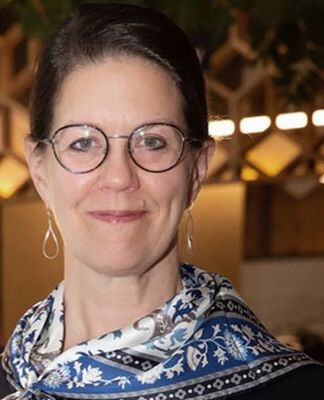Monica Denevan studied photography at San Francisco State University. Her ongoing series, "Songs of the River: Portraits from Burma," began in 2000. Since then, she has returned to many of the same small villages in Burma/Myanmar, making intimate photographs of fishermen and their families in the spare and graphic setting of the Irrawaddy River. She travels with a medium format film camera, one lens, and bags of film, working with natural light and making composed images. Once home, she makes photographic prints in her traditional darkroom.
Denevan's photographs have been exhibited internationally including solo shows at Scott Nichols Gallery (Sonoma, CA), Duncan Miller Gallery (Santa Monica, CA), Tao Gallery (Hong Kong) and Serindia Gallery Annex (Bangkok.) In 2020, she was one of 25 artists included in Photo-Eye Gallery's (Santa Fe, NM) first-ever juried exhibition. Her work is currently displayed on The Strand Cruise ship in Burma/Myanmar. She was a Photolucida Critical Mass Top 50 finalist in 2019 and 2012. In 2016, ten of Denevan's images were published in a book of Lao photographs published by Nazraeli Press and Friends Without A Border in NY. In addition, her photographs have been published in ZYZZYVA, LensWork, SHOTS, and Bangkok Airways Inflight Magazine among others. She is the All About Photo 2020 Photographer of the Year award recipient. Monica Denevan is represented by Scott Nichols Gallery. She lives and works in San Francisco.
Statement
In my ongoing series "Songs of the River: Portraits from Burma," I make portraits of fishermen and their families by the Irrawaddy River.
Burma (Myanmar) has a long troubled history, which continues into the present and now receives much more international notice and condemnation since my first trip in 2000. However, little has changed in the quiet villages I often visit. Generations of families live together in thatched roofed huts built on stilts. Women wash clothes in the river. Girls collect river water in large plastic containers that they balance on their heads. Men and boys are often out all night fishing. In the evening, children play, sing, bathe, and joke around at the river's edge. The sounds echo over the water.
When in the villages, I am most interested in making portraits of the people I spend my time with, some of whom I have photographed since I first visited the country. I am grateful to be allowed briefly into their lives. The nearby area is stark, minimal, and ever changing, and I use that environment in my photographs. The landscape becomes another subject, another portrait within the picture. As families grow, I incorporate new people into my images, combining the spare, external world with the physicality of the individual. To return to the same place annually and find a new way to see it or to look for what is different is a daily adventure that I enjoy.
